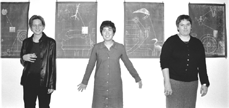

The works of seniors Ginger Brooks, Jocelyn Jacobs and Katy Higgins featured in their joint exhibition, "Past," display a variety of distinctive approaches to more or less autobiographical themes.
In screenprints, woodcuts and an installation, Brooks expresses an interest in her mother's life as a young woman and a desire to connect with that past. Although Brooks works within the conventional vocabulary of contemporary screenprinting, she makes effective use of these techniques in dealing with her subject matter.

The muted tones and colors of "pipe dreams" and "landscape," based on photographs of her mother, recall faded family photos, making the past which they depict seem distant and unreachable. At the same time, their color scheme is suggestive of some Oriental art, an aspect which introduces the idea of cultural as well as generational differences separating Brooks from her mother.
The exhibit also featured Brooks' first installation work, "decades no.2," which addressed her maternal grandmother's move from Japan to America and her own visit to Japan last year, during which she studied woodblock printing. The entrance to the installation consisted of broken boards and wooden skids and large PVC piping between billowing sheets, creating the sense of a bridge or a ship traveling across water. Inside were photographs of her mother and grandmother lit by flashlights in an otherwise dark space, again suggesting Brooks' distance from them in time and culture.
Brooks' woodblock prints, including the triptych "i remember searching for the perfect words," are highly reflective of current trends in style and subject matter, but like her other works, they display her impressive command of media.
Jocelyn Jacobs' works in oil paint, pastels, collage and other media generally possess a rough, expressive quality. Dealing with subjects of childhood, the works themselves initially produce a childish and simplistic impression. However, as this quality is carried out in the titles as well as the works themselves, the simplicity becomes so blatant that it begins to seem like an intentional and conscious rejection of any more complex interpretation. For instance, Jacobs' paintings "babies I" and "babies II" consist simply of painted and drawn images of babies, seeming to focus on the sensual use of color and image.
Other works of Jacobs' make clever and creative use of a childlike sense of perception. For example, "where i come from" includes an outside view of a house seen in distorted perspective from three sides at once. An inside view of the house is imposed onto the surrounding landscape, featuring a Christmas tree and presents labeled "thing." The skewed sense of importance and reality in this work suggests a child's understanding of the world.
Katy Higgins' contributions are the most aesthetically original and sophisticated in the show, incorporating a variety of media ranging from 19th century photographic techniques to crochet. In creating "Blueprints," Higgins used computer graphics programs to juxtapose photographs of birds and sea life with biological and mechanical diagrams, and then printed negatives of these images to produce cyanotypes. The implicit and explicit parallels drawn between the structural components of living animals and the components of a machine are in some instances quite unnerving.
Another of Higgins' works, "Remains," includes small animal-like objects made of fingernail clippings, shells, and paraffin sealed in glass jars. Higgins photographed these objects and made a montage of gum prints of the photos, which hangs over the jars. The photographic technique used in making gum prints produces ghostly images, contrasting with the scientific sterility of the objects displayed in jars.
An altogether different effect is created by Higgins' small installation of crocheted jellyfish and other sea animals suspended and lit from above inside a small enclosed room. In this case, the coldness with which organic objects were presented in her other works is replaced by the ideas of care and personal investment intrinsic to folk arts such as crochet.
Although the works in the show differed in media, intention and complexity, all of the featured artists displayed a level of technical maturity that bodes well for the spring art show season.
Meet the artists: A healthy crowd turned out in Fisher Hall this past Monday to do just that, and get a chance to see the work of (from left to right) seniors Jocelyn Jacobs, Ginger Brooks and Katherine P. Higgins. The trio pose in front of Higgins' re-imagining of blueprints. (photo by PaulineShapiro)
Copyright © 1998, The Oberlin Review.
Volume 127, Number 12, December 11, 1998
Contact us with your comments and suggestions.